#queen anne
Text



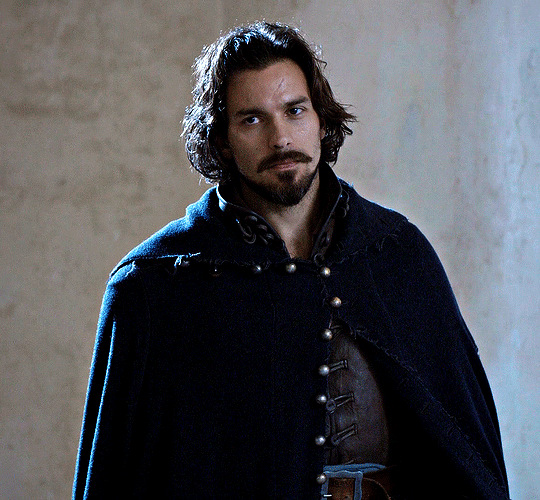

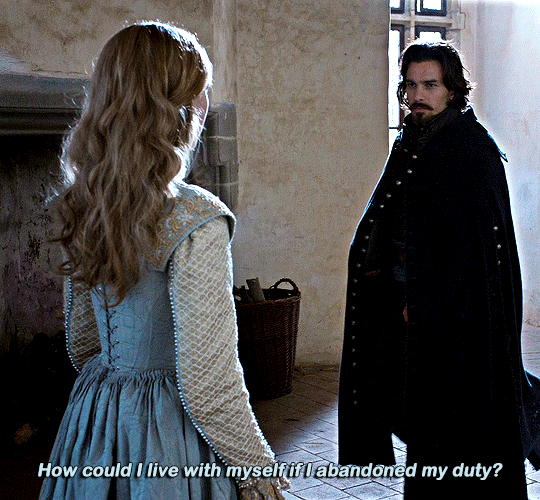


THE MUSKETEERS
2.09 “The Accused”
#queen anne#aramis#the musketeers#the musketeers bbc#themusketeersedit#perioddramaedit#cinematv#cinemapix#chewieblog#dailyflicks#useroptional#perioddramasource#weloveperioddrama#tvarchive#smallscreensource#tvedit#alexandra dowling#santiago cabrera#requested
800 notes
·
View notes
Photo
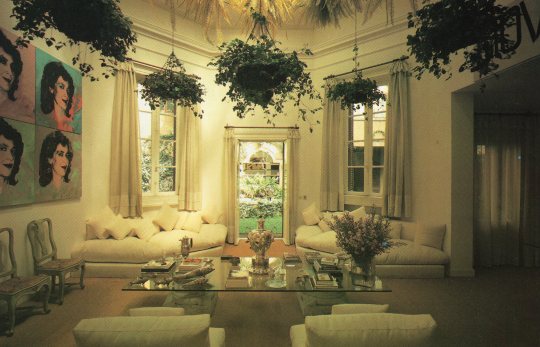
Rooms by Design, 1989
#vintage#vintage interior#1980s#80s#interior design#home decor#living room#Queen Anne#chairs#Warhol#house plants#neutral#beige#furniture#contemporary#style#home#architecture
748 notes
·
View notes
Text
Tumblr Dashboard Simulator: 1670s/1680s English Court
🐶 merry-monarch

#monday motivation #motivational quote #there are indeed good thyngs and bad in this countrie #the good: women #the bad: PARLEMENT
5,112 notes

💖 mary-clorine
I have two husbands, and that causes me much trouble and torment of the soul, for I may be with childe by one, and have thus given horns to th'other, who is also a lady, and we have been married first. Now she won't writ to me as we did as girles, and my lawfull husband, I have not yett told, for my condition is not certain yet. I cannot talk in honesty whith one, and with the other husband, neither.
'Tis awkward to speak of this, but if not to your friends online, to whom can one talk of such troubles?
#personal #might remove later #aurelia I miss you
2 notes

🤴dukeofm
There are thyngs the governement, the Kinge in particular, do not wish you to know about: the Royall Successioun is all made false, for instead of the D. of Yorke, the True Heir to H. M. the Kinge shoud be the Duke of Monmouth, for he was lawfully begot by the Kinge, then married in secret to the late Lucy Walter, and must therefore be accepted as Prince before his uncle the D. of Yorke, who is a Catholick.
All ye good people should speak up against this injustice! If you cannot pledge your life (if there be a fight), or some shillings to the cause, you may help it greatly alreadie by re-bloggying, and bringing this mater to greater awareness!
#sociall justice #awareness #politick
798 notes

🎀 prettywittynell
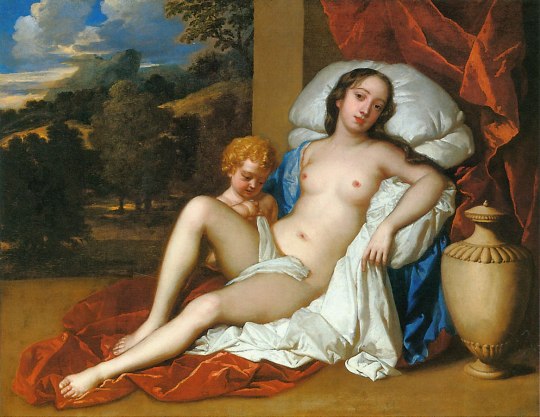
@merry-monarch had me painted! For more content like this, and to vote which painter shoud doe me (haha!) next, please visit my OnlieFriendes account!!!
#lely #girlboss #hotter than madam carwell!! ;)))
1,723 notes

🍊 je-maintiendrai
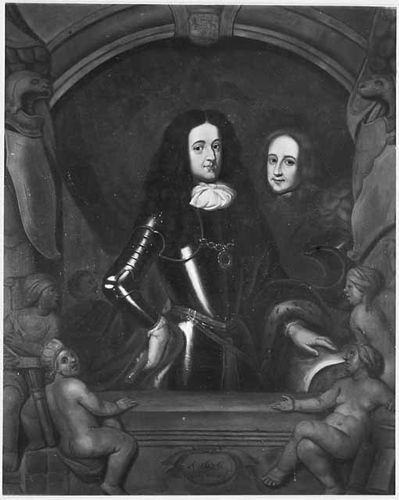
Hans Willem et moy!
Vouz pouves nous voir en visitant Stichting Kasteel Amerongen, ou icy, en-ligne (un grand mercy au Nederlands Instituut voor Kunstgeschiedenis): https://rkd.nl/images/126807
#meilleur amy #boy best friends #louis n'a pas d'amy si proche que j'ay
905 notes

👑 catholic-guilty666
Why cannot a man haue normall nepheues. One, @je-maintiendrai, is nigh a Puritan in his Protestant fervour, and th'other dispreads falsehoods about the monarcky (and the Roman Church).
I reported the other one, @dukeofm for his libel, in hopes he shall be deactivated, alas th'other I can but block, and not banished from this place. I also hope my daughter the Princess shall divorce him speedilye.
Tonight, I hope to forgett all about this vexing bussinesse by thinking on going a-stag hunting tomorrow with H. M. my brothere, the King.
#vent #vent post #callout post
14 notes

🇮🇹modenamarie
#poll #nicknames #mary
244 notes

💃 annieannieannie

3. The feeling One experiences when One findes out, that one's weird uncle hath a Tumblr-accountt, too 💀💀💀

do not follow him
#i thought 'twas my bad eyes but what i was seeing was real #the family #non followeres do not interact
38 notes
#history humour#unreality#fake tumblr post#for true immersion you can vote in maria beatrice's poll!#17th century#the stuarts#charles ii#mary ii#nell gwynn#william iii#william of orange#james duke of monmouth#james ii#mary of modena#queen anne#british history
150 notes
·
View notes
Text
⚜️ Happy 10th Birthday, The Musketeers! ⚜️
The Musketeers premiered on BBC One on 19 January 2014 and ran from 2014 to 2016, with a total of 30 episodes.

Inspired by Alexandre Dumas' novel, it starred Tom Burke, Santiago Cabrera, Howard Charles, and Luke Pasqualino as the four loyal swordsmen in 17th-century France, who fight for justice and protect the King and Queen from various threats.
⚜️ ⚜️ ⚜️ Athos ⚜️ ⚜️ ⚜️

⚜️ ⚜️ ⚜️ Aramis ⚜️ ⚜️ ⚜️

⚜️ ⚜️ ⚜️ Porthos ⚜️ ⚜️ ⚜️
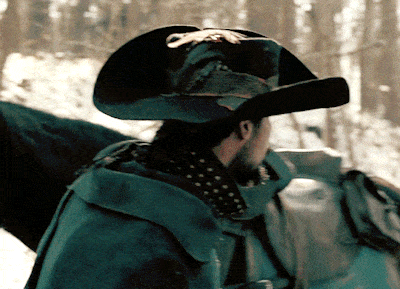
⚜️ ⚜️ ⚜️ D'Artagnan ⚜️ ⚜️ ⚜️

"I'm looking for Athos!"
"You've found him."
"My name is d'Artagnan, of Lupiac in Gascony. Prepare to fight. One of us dies here."
"Now, THAT'S the way to make an entrance."
– 1x01 Friends and Enemies
The series blends historical drama,
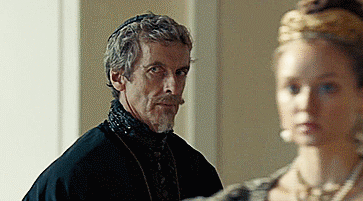
action,

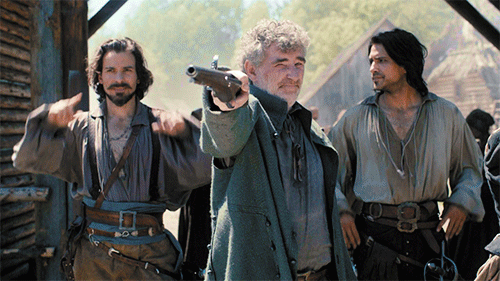
intrigue,

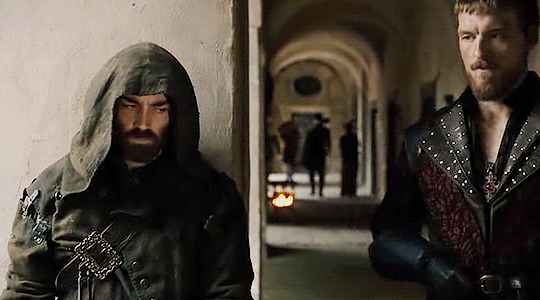
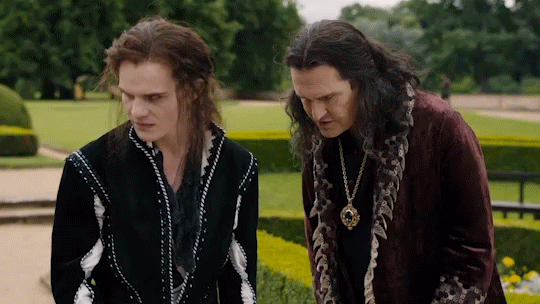
and humour,
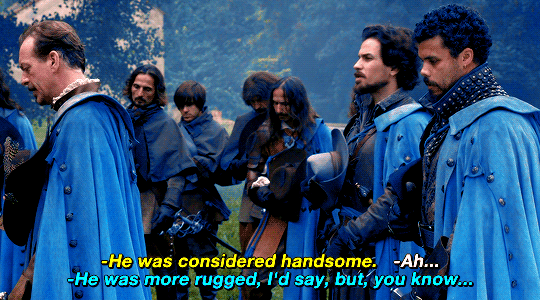

with a healthy serving of family,

romance,

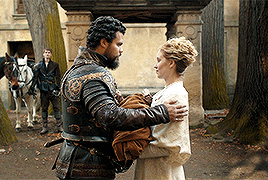
and plenty of friendship,

brotherhood,


and swashbuckling goodness!


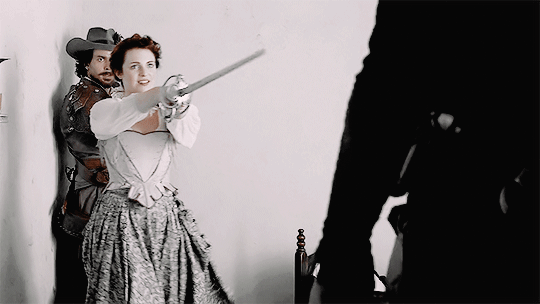
"I want… Athos and his friends… silenced for good."
"Musketeers don't die easily."
– 1x10 Musketeers Don't Die Easily
⚜️ Thanks for an amazing show! ❤️🔥⚜️
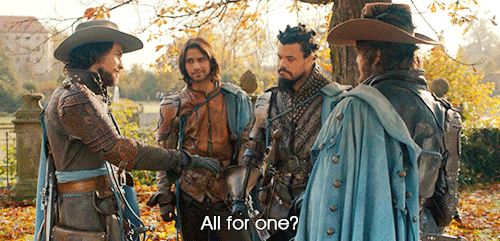

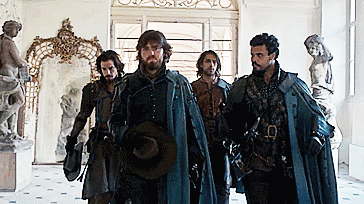

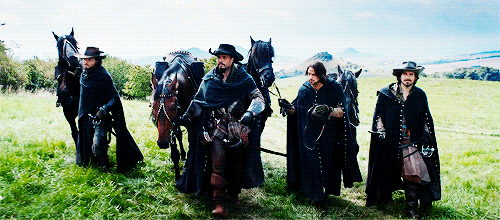



"Look to your left, now your right... A Musketeer is never alone, Brujon.
Remember that."
– 3x03 Brothers in Arms
⚜️💖⚜️
*My thanks to all the amazing gif makers for the lovely gifs!
#bbc musketeers#the musketeers#10th anniversary#the inseparables#captain treville#constance bonacieux#queen anne#king louis xiii#milady de winter#slyvie#cardinal richelieu#rochefort#lucien grimaud#marquis de feron#⚔⚜#tom burke#howard charles#santiago cabrera#luke pasqualino#hugo speer#tamla kari#alexandra dowling#ryan gage#maimie mccoy#thalissa teixeira#peter capaldi#marc warren#matthew mcnulty#rupert everett#600th
149 notes
·
View notes
Text
If I had a nickel for every time Santiago Cabrera played a character on a BBC show who was a noble, loyal and highly skilled knight/soldier, who served the king, was a hopeless romantic with only one or two main love interests, the Queen being one of his love interests who he an affair with, leading to life-altering long-term consequences, for both him and the Queen, I’d have two nickels.
Which isn’t a lot but it’s weird that it happened twice.


I’m not even mad, BBC writers were either onto something or on something when they wrote Lancelot and Aramis.
I’m sure there’s more comparisons, but I’m not finished watching yet so I’m just hoping Aramis doesn’t get banished or anything. They probably won’t kill him, but *
*it was at this point that I realised there’s been foreshadowing and I’m not saying anything because I don’t want to jinx it so I’m just gonna leave this here.
#I just watched episode 9#Knight Takes Queen#lancelot du lac#i had to#santiago cabrera#lancelot#sir lancelot#aramis#bbc musketeers#bbc merlin#if i had a nickel#i’m bad at tagging#queen anne#queen guinevere#guinevere
110 notes
·
View notes
Photo
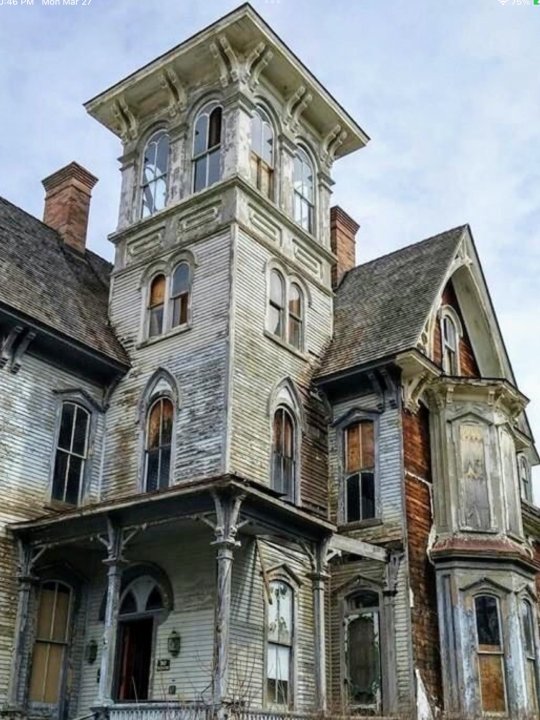
610 notes
·
View notes
Text
Constance: Anne, why aren't you dressed yet?
Anne: I... uh... have nothing to wear
[Constance starts going through her closet]
Constance: You have nine robes, sixteen gowns, eight shirts- hey Aramis, and six pairs of pants
#incorrect quotes#the musketeers#lol#bbc musketeers#aramis#santiago cabrera#queen anne#anne of austria#alexandra dowling#aramis x anne#annamis#otp#constance#tamla kari#musketeers#the three musketeers#alexandre dumas#anne x aramis#original post
110 notes
·
View notes
Text
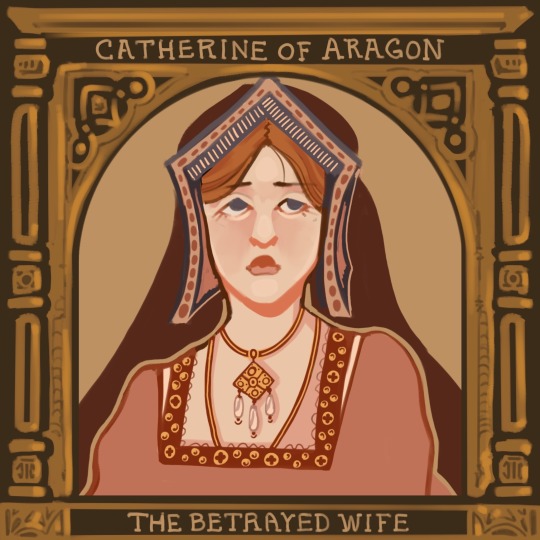



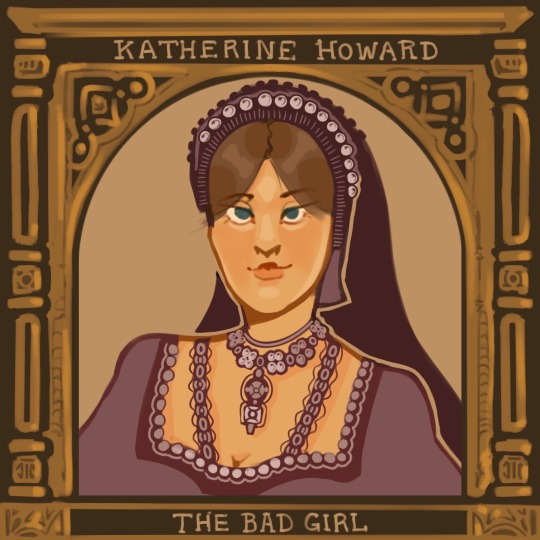

1. Catherine of Aragon (married 1509-1533)
motto: HUMBLE AND LOYAL
Even allowing for tactful hyperbole, it is clear that Catherine, […] did have the kind of youthful prettiness and freshness of appearance that charmed observers, not only the family into which she would marry. It was partly a question of her complexion: her naturally pink cheeks and white skin were much admired in an age when make-up was clumsy in execution, easy to detect and much scorned. Ambassadors abroad, describing princesses to their masters, generally emphasized the tint of the skin, carefully noting whether it was 'painted' or not. A fair complexion like Catherine's was thought to indicate a more serene and cheerful temperament than a 'brown' one. Then Catherine's hair was also fair and thick, with a reddish-gold tint, her features neat and regular in a pleasingly shaped oval face.
Perhaps Catherine's fair colouring, so far from the conventional picture of a dark-visaged Spaniard, reminded onlookers of her one-eighth of English blood: […] 'there is nothing wanting in her that the most beautiful girl should have. '
If her complexion was her chief beauty, Catherine's chief disadvantage was her lack of height. All the grace of her bearing, inculcated over many years at the Castilian court, could not conceal the fact that she was extremely short, even tiny. Years later a loyal defender had to admit that she was 'in stature somewhat mean', while adding quickly 'but bonarly [bonnie] withal'. She was also on the plump side - but then a pleasant roundness in youth was considered to be desirable at this period, a pointer to future fertility. In contrast Catherine's voice was surprisingly low and 'big-sounding' for a woman; and that no doubt contributed to the impression of gracious dignity she left on all observers, making up for the lack of inches.
2. Anne Boleyn (married 1533-1536)
motto: THE MOST HAPPY
Anne Boleyn was not a great beauty. The Venetian ambassador […] pronounced her 'not one of the handsomest women in the world'. […] Anne Boleyn was only moderately pretty.
Some of this lukewarm praise may have been due to the fact that her looks did not accord with the fair-haired, blue-eyed ideal of the time. In theory, dark looks were regarded with suspicion and Anne Boleyn's looks were conspicuously dark: she was 'Brunet' […] Anne Boleyn's olive complexion’ […] her colouring 'rather dark' or sallow 'as if troubled with jaundice', or 'not so whitely as ... above all we may esteem.' She did have a few moles, although she was hardly disfigured by them on the contrary they acted as beauty-spots. Her hair, thick and lustrous as it might be, was extremely dark […] And her eyes were so dark as to be almost black. But then the theory of public admiration was one thing - blondes were supposed to be of cheerful temperament - and the practice of physical attraction was quite another. Clearly in adulthood Anne Boleyn exercised a kind of sexual fascination over most men who met her; whether it aroused desire or hostility, the fascination was there.
The black eyes were sparkling and expressive; and they were set off by those 'dark, silky and well-marked eyebrows' […] on the subject: she knew well how 'to use [her eyes] with effect', whether deliberately leaving them in repose or using them to send a silent message which carried ‘the secret testimony of the heart'. As a result many became obedient to their power. More prosaically, the Venetian ambassador called her eyes "black and beautiful'. Her mouth, described by him as 'wide' (another theoretical disadvantage by the standards of the time), was recorded by Sander as pretty. […] Anne Boleyn was 'of middling stature' (which made her of course a great deal taller than Queen Catherine). She seems to have been quite slight or at any rate not full-breasted - the Venetian ambassador remarked that her bosom was 'not much raised' […]. But a much more important aspect of her appearance when she first came to court was her elegant long neck; this, with the deportment she had learned in France […] gave her a special grace, especially when dancing, which no one denied.
The fresh young damsel had other qualities, some more obvious than others at the moment of her arrival back in England. She had 'a very good wit', wrote Cavendish in his Life of Wolsey, another source not prejudiced in Anne Boleyn's favour? The phrase, going beyond mere intelligence, carried with it connotations of spirit and adventurousness; in other words, Anne Boleyn was good company. Like many spirited people, she had another more impatient side to her: she would display on occasion a quick temper and a sharp tongue. But of these characteristics, deplored in a woman as much as skill at singing and dancing was prized, there was as yet no sign.
3. Jane Seymour (married 1536-1537)
motto: BOUND TO OBEY AND SERVE
From other sources, it seems likely that the charm of her character considerably outweighed the charm of her appearance: […] of middle statute and no great beauty. Her most distinctive aspect was her famously pure white complexion. Holbein gives her a long nose, and firm mouth, with the lips slighty compressed, although her face son a pleasing oval shape with the high forehead then admired (enhanced sometimes by discret plucking of the hairline) and set off by the headdresses of the time. Altogether, if Anne
Boleyn conveys the fascination of the new, there is a dignified but slightly stolid look to Jane Seymour, appropriately reminiscent of English medieval consorts.
But the predominant impression given by her portrait - at the hands of a master of artistic realism - is a young woman of calm good sense. And contemporaries all commented on Jane Seymour's intelligence: in this she was clearly more like her cautious brother Edward than her dashing brother Tom. She was also naturally sweet-natured (no angry words or tantrums here) and virtuous - her virtue was another topic on which there was general agreement. There was a story that she had been attached to the son of Sir Robert and Lady Dormer, a country neighbour, but was thought of too modest a rank to marry him; even if true, the tale brought with it no slur on Jane's maidenly honour. It was told more as a Cinderella story, where the unfairly slighted girl would go on to be raised triumphantly to far greater heights. Her survival as a lady-in-waiting to two Queens at the Tudor court still with a spotless reputation may indeed be seen as a testament to both Jane Seymour's salient characteristics - virtue and common good sense. A Bessie Blount or Madge Shelton might fool around, Anne Boleyn might listen or even accede to the seductive wooings of Lord Percy: but Jane Seymour was unquestionably virginal.
In short, Jane Seymour was exactly the kind of female praised by the contemporary handbooks to correct conduct; just as Anne Boleyn had been the sort they warned against. There was certainly no threatening sexuality about her. Nor is it necessary to believe that her 'virtue' was in some way hypocritically assumed, in order to intrigue the King […]. On the contrary, Jane Seymour was simply fulfilling the expectations for a female of her time and class: it was Anne Boleyn who was - or rather who had been - the fascinating outsider.
4. Anne of Cleves (married 1540-1540)
motto: GOD SEND ME WELL TO KEEP
Let us take the actual appearance of Anna of Cleves first: for this we are fortunate in having a first-hand description, written only a few days later by the French ambassador, Charles de Marillac, who was not prejudiced in either direction, towards her beauty or her ugliness. Anna of Cleves looked about thirty, he wrote (she was in fact twenty-four), tall and thin, 'of middling beauty, with a determined and resolute countenance.' The Lady was not as handsome as people had affirmed she was, nor as young […], but there was a steadiness of purpose in her face to counteract her want of beauty.
The 'daughter of Cleves' was solemn, or at any rate by English standards she was, and she looked old for her age. She was solemn because she had not been trained to be anything else and the German fashions did little to give an impression of youthful charm in a court in love as ever with things French, or at any rate associating them with fun and delight. […] Turning to Holbein's picture, one finds this solemnity well captured: a critic might indeed term it stolidity. Besides Wotton, in his report, had confirmed that Holbein, generally regarded as the master of the 'lively' or lifelike (not the flattering) in his own time, had indeed captured Anna's "image' very well.
Of course a beautiful young woman, however stolid or badly dressed, would still have been acceptable. Anna of Cleves was not beautiful, and those reports which declared she was were egregious exaggerations in the interests of diplomats […]. But was Anna of Cleves actually hideous? Holbein, painting her full-face, as was the custom, does not make her so to the modern eye, with her high forehead, wide-apart, heavy-lidded eyes and pointed chin.
There is indirect evidence that Anna of Cleves was perfectly pleasant-looking from the later years of Henry VIII. When Chapuys reported Anna of Cleves as rating her contemporary, Catherine Parr, 'not nearly as beautiful' as herself, this expert observer did not choose to contradict her; so that the boast was presumably true, or at least true enough not to be ridiculous.
5. Katherine Howard (married 1540-1542)
motto: NO OTHER WILL BUT HIS
No confirmed authentic picture of Katherine Howard survives. The fact that Katherine Howard is the only one of Henry VIII’s wives for whose appearance we must rely properly on contemporary descriptions, gives her career an appropriately evanescent quality. The same mistiness surrounds her date of birth. She was eighteen or nineteen when the King’s roving eye first fell upon her: that is, roughly thirty years younger than he was. […] Katherine was not only small, as Catherine of Aragon had been, but diminutive: parvissima puella – a really tiny girl. If King Henry was about thirty years older than Katherine, he must have been well over a foot taller. We need not speculate further about their respective weights. The French ambassador rated her beauty as only middling (the same phrase he had used for Anna of Cleves, incidentally), but he did praise her gracefulness, and he found much sweetness in her expression; her habit of dressing à la française (as opposed to Anna of Cleves’ Germanic fashions) no doubt commended itself to him.
Even if Katherine Howard was not a beauty, she must have had considerable prettiness and obvious sex appeal (as well as – or perhaps because of – her youth) since we know that she captivated the King instantly.
6. Catherine Parr (married 1543-1547)
motto: TO BE USEFUL IN ALL I DO
The woman who brought about this cheerfulness, the new Queen Catherine Parr, was herself never described by anyone as a beauty: even the term ‘of middling beauty’ used for both Anna of Cleves and Jane Seymour by Marillac was not applied in this case. ‘Pleasing’ and ‘lively’, ‘kind’ and ‘gracious’ were the most flattering epithets ascribed to her. It is true that a difference of age and status may have been responsible for this lack – widows of over thirty were not expected to be beauties – but when Anna of Cleves indignantly exclaimed that the new Queen was ‘not nearly as beautiful as she’, Chapuys, passing on the comment, did not see fit to contradict it.
Queen Catherine Parr’s only known authentic likeness, attributed to William Scrots, shows an amiable face rather than an intriguing one; the nose is short, the mouth small, and the forehead broad rather than domed in the way that contemporaries admired. Her hair was rather similar in colour to that of Catherine of Aragon: light auburn, tinged with what Agnes Strickland in the nineteenth century would call ‘threads of burnished gold’.
But if the new Queen Catherine was not a beauty, she was neither dull nor austere. She enjoyed dancing. […] She was well set up – the tallest of King Henry’s wives – and her height would have enabled her to cut a regal figure since her conception of her role as queen consort also included a great deal of ornate dressing-up.
Bibliography:
- Fraser, Antonia. The Six Wives of Henry VIII. New York Knopf, 1993.
#henry viii#princess catherine#catherine of aragon#anne boleyn#queen anne#jane seymour#anne of cleves#katherine howard#catherine parr#procreateart#digitaldraw#digitalillustration#renaissance#medieval#english history#monarchy#the tudors#king henry viii#quotes#illustration#england
137 notes
·
View notes
Text

Queen Anne cooking for the Musketeers.
92 notes
·
View notes
Text
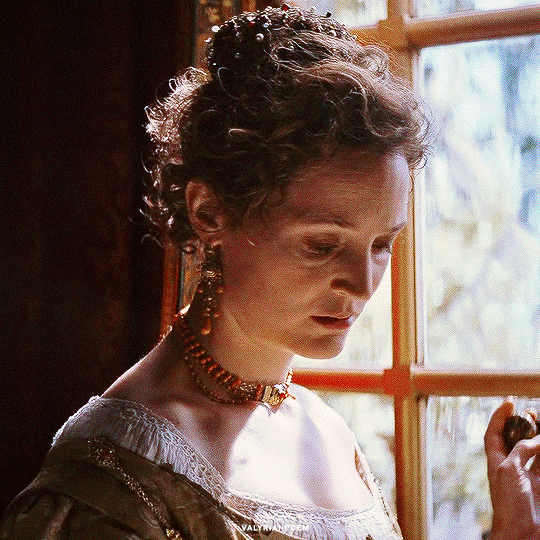


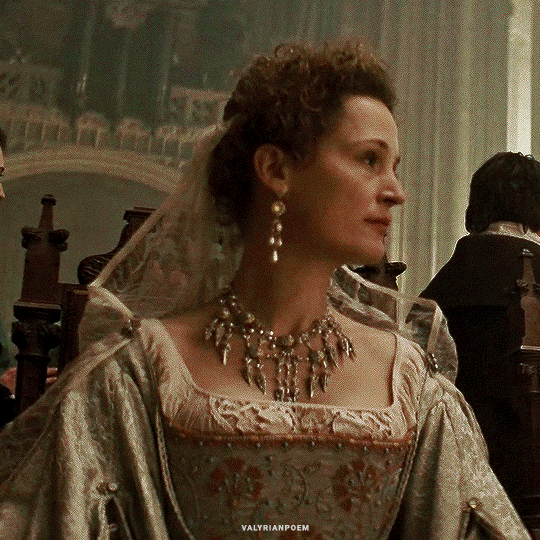


Vicky Krieps as ANNE OF AUSTRIA
The Three Musketeers: D'Artagnan (2023)
#vicky krieps#queen anne#anne of austria#the three musketeers#the three musketeers: d'artagnan#gifshistorical#userbennet#historicwomendaily#perioddramaedit#perioddramasource#weloveperioddrama#onlyperioddramas#ladiesofcinema#period drama#my edit#costume drama#t3mgifs
166 notes
·
View notes
Text
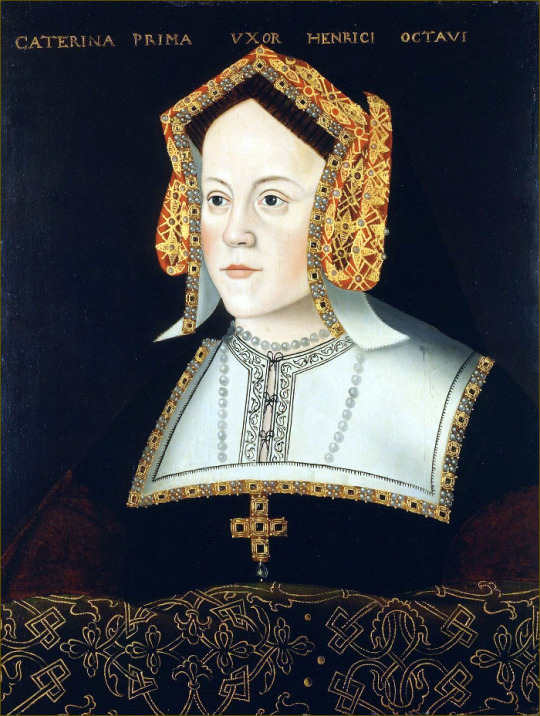









Pattern Portraits of the Six Wives of Henry VIII (part one): Catherine of Aragon and Anne Boleyn
#catherine of aragon#katherine of aragon#catalina de aragon#anne boleyn#anna bolina#queen anne boleyn#tudor history#henry viii#the tudors#english history#tudor era#tudor england#tudor rose#tudor period#house of tudor#tudor dynasty#six wives of henry viii#the six wives of henry viii#art#art history#sixteenth century#16th century#16th century art#queen anne#queen katharine
42 notes
·
View notes
Text

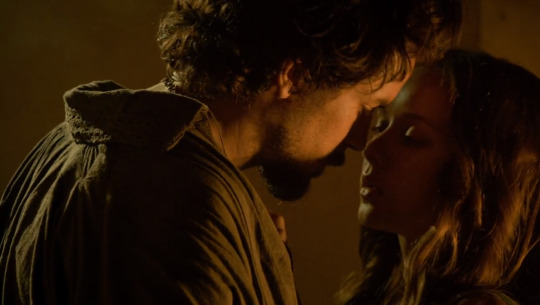






Knight and Queen
62 notes
·
View notes
Text

Special touches in the dining room include the slipcovering of alternate chairs to give variety and the use of a starched white tablecloth over a patterned one. On the table, basil plants in china pots scent the air more deliciously than any potpourri.
The French Touch: Decoration and Design in the Most Beautiful Homes in France, 1988
#vintage#vintage interior#1980s#80s#interior design#home decor#dining room#cupboard#china#floral#slipcover#basil#Queen Anne#chair#dinner party#France#French#classical#style#home#architecture
65 notes
·
View notes
Photo
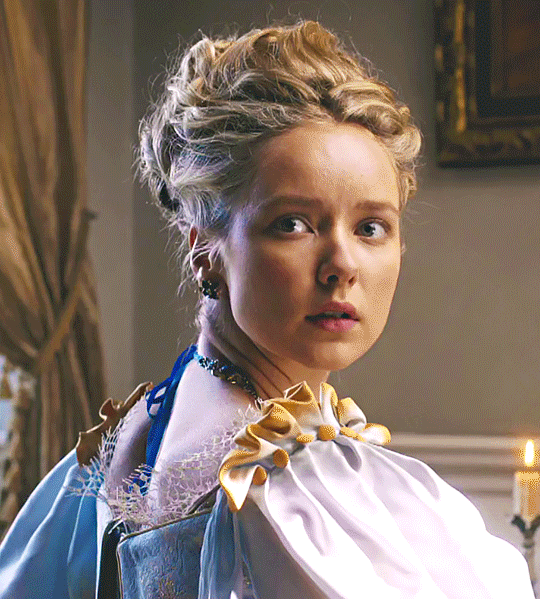



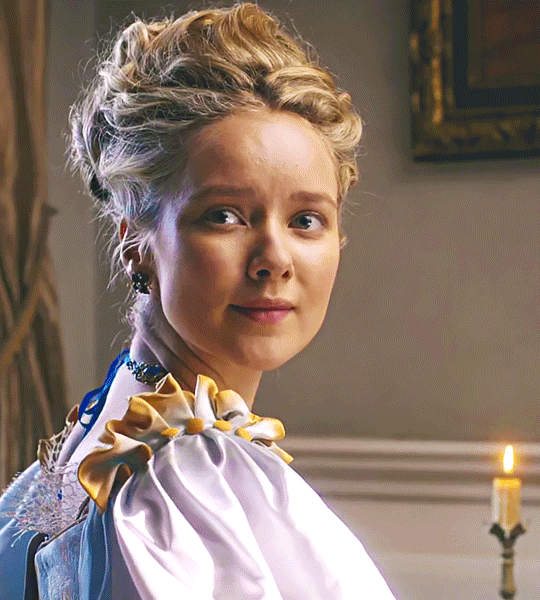
ALEXANDRA DOWLING as QUEEN ANNE in THE MUSKETEERS (2014-2016)
#the musketeers#musketeersedit#themusketeersedit#queen anne#Alexandra Dowling#periodedit#perioddramaedit#perioddramasource#weloveperioddrama#adaptationsdaily#tvedit#ours#gifs#TV show#by fish
521 notes
·
View notes
Text
Where are my fanfics where the queen goes full feral after S2 and takes no ones shit (least of all the Kings (you believed him Louis, over me, and you'll be paying me back for that the rest of our lives)) instead of becoming too catious and subdued in fear of her position
The fics where she says fuck you I am the queen of France and these are my Musketeers
Where she calls the boys her friends and calls on them as her regular guard just so they can hang out and turns her nose up at Louis when he seeths about it
Where she has our 4 musketeers raise her son, the future king of France, because she knows that this county that is hers now deserve better than the type of King Louis would raise
Where she writes to them at the front to check on them and to provide intel on Spain because she was a Spanish princess but now she is Queen of France and that is who she it. The woman that forces her was into the war councils to beat knowledge of Spanish politic and land and strategy into the men that have led her county into war (the war her marriage was supposed to prevent the the first place)
Fics where she gossips and spends time with Constance talking about their musketeers, where she's snubbed by the king at another ball so goes to her noble Athos for a dance instead, where she asks Porthos to teach her how to defend herself, where she teases D'Artagnan about being a baby musketeer so he tells her all the embarrassing stories about the other three that they would never want her to know until she is crying with laughter, and yes, when she tells Aramis not to go because she needs a friend and if you leave people will still talk but then I would be alone so he stays
Because I want all the fics
#bbc musketeers#bbc the musketeers#musketeers#queen anne#aramis#athos#d'artagnan#porthos#constance bonacieux#king louis#musketeers fanfiction#posts by rae
178 notes
·
View notes
Text
The Painted Hall, Greenwich

During the king’s coronation I visited Greenwich's "Painted Hall." This series of rooms depict scenes relating to the success of British Protestantism and the beginning of burgeoning imperial expansion. Following the vital English naval victory over France at La Hougue in 1692, Queen Mary ordered that a hospital be built for retired seamen, in keeping with the existing hospital for former soldiers at Chelsea.
While Mary died before its completion her husband, William III, saw the projected through. Sir Christopher Wren (of St Paul’s fame) and his assistant, Nicholas Hawksmoor, designed a grand series of buildings at Greenwich, in London.
The Royal Hospital at Greenwich acted as a retirement home for sailors between the 1700s and late 1900s. And at its heart is the Painted Hall, a series of rooms where a relatively unknown artist, James Thornhill, was commissioned to paint scenes of British-Protestant triumph.
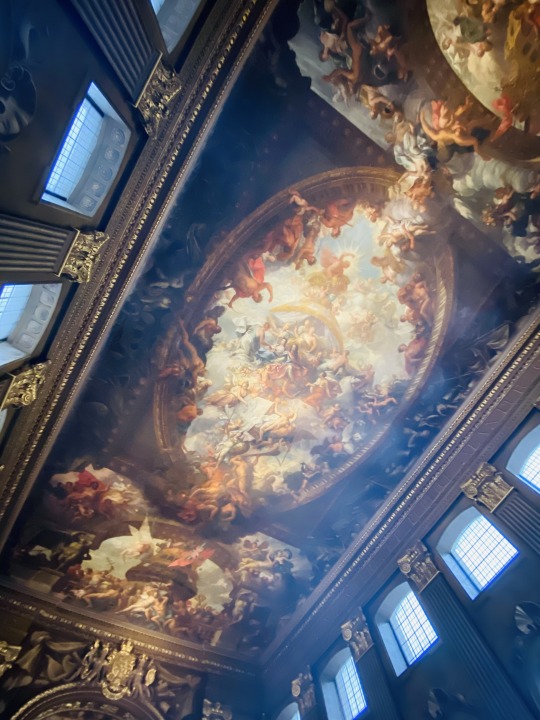
At the centre is King William III and Queen Mary shown overseeing ‘The Triumph of Peace and Liberty over Tyranny.’ Immediately above the couple and to their left is the allegorical figure of Prudence holding a mirror, one of the four Cardinal Virtues.

To her right are Providence and Concord, while to her left is Justice. Beneath Justice is a woman representing Europe, who is accepting the ‘cap of liberty,’ the ancient red Phrygian cap, from William, who in turn is accepting an olive branch from ‘Peace.’

Beneath William’s foot is the defeated Louis XIV of France with a broken sword, and a tumbling, discarded papal crown. Beneath them the ‘Spirit of Architecture’ along with Truth and Time are overseeing plans showing the actual construction of the hospital.
Above it all, Apollo rides his chariot, while the signs of the zodiac are arrayed around the edges. At the bottom, Pallas Athena and Hercules crush the Hydra and the Gorgon, ‘expelling the Vices from the Kingdom of William and Mary.’

Another section of the ceiling shows a captured Spanish galley laden with the spoils of war, a reference to the British capture of Gibraltar in 1704. Diana, Goddess of the moon, passes mastery of the tides over to British sailors. Beneath them are representations of the English rivers Avon, Severn and Humber.
To the left and the right, scientific advancement is celebrated by the presence of astronomers Tycho Brahe, John Flamsteed, Copernicus and Newton’s ‘Principia.’ The gods Neptune and Cybele oversee it all.
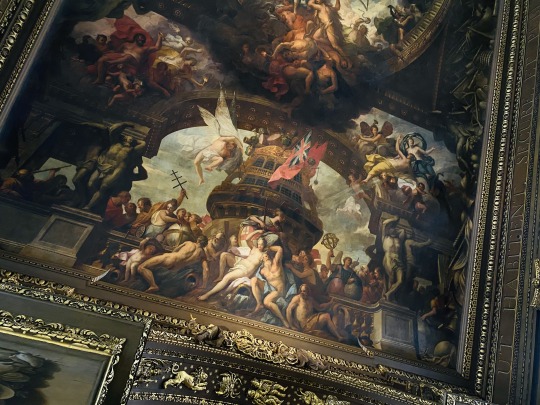
The next section of the ceiling shows HMS Blenheim being filled with the spoils of war by the winged figure of Victory. Beneath are more river representations along with the City of London and figures representing navigation and astronomy. On the left is Galileo, while Zeus and Juno watch from above.

The painted hall took decades to complete, and saw further dynastic change, as George I, originally of Hanover, became king after William III’s successor, Queen Anne, died. George maintained the Protestant ascendancy, as portrayed in the upper hall chamber adjoining the main hall.
Here we see George I, his wife Sophia of Hanover and their children and grandchildren beneath St Paul’s, overseen the a figure representing “the Golden Age” with overflowing cornucopia. The artist, James Thornhill, added himself on the right.
Over them is an inscription quoting Virgil's Eclogues, which translates as ‘a new generation has descended from the heavens.’
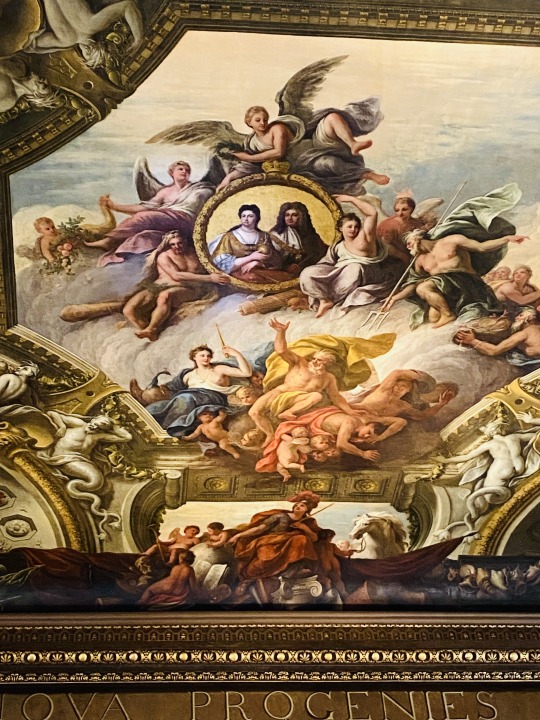
On the left of the upper hall is a depiction of William III’s arrival in England at the start of the Glorious Revolution in 1688, while George I is shown arriving on the opposite side of the hall (rather unrealistically in a chariot) in 1714.
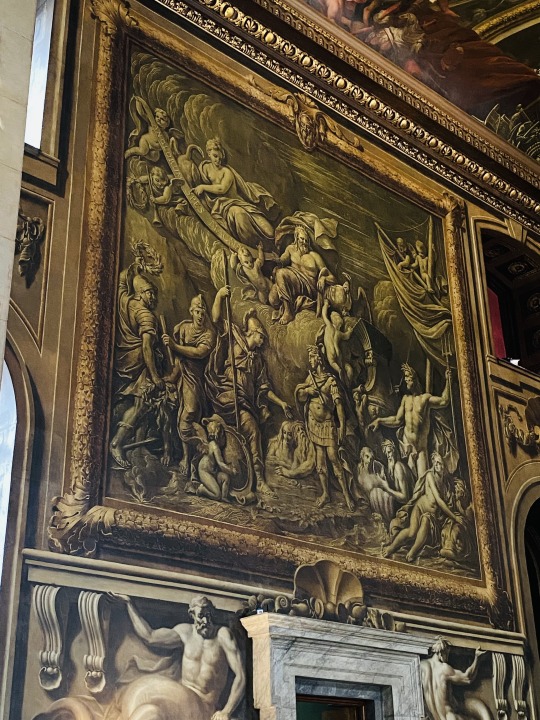
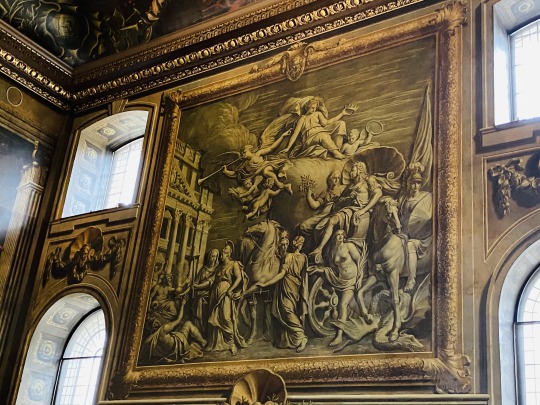
#painted hall#the painted hall#greenwich#history#british history#art#art history#william iii#william of orange#william and mary#george i#queen anne#17th century#18th century
132 notes
·
View notes